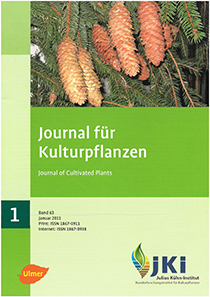Quantitativer Nachweis von <em>Verticillium dahliae</em> im Boden als Grundlage der Flächenauswahl im Gartenbau
DOI:
https://doi.org/10.5073/JfK.2011.01.01Schlagworte:
Verticillium dahliae, Verticillium longisporum, Bodenuntersuchungen, Erdbeeren, AcerAbstract
Verticillium dahliae verursacht im Gartenbau, insbesondere bei Erdbeeren und Alleebäumen, große wirtschaftliche Schäden, die vielfach auf verseuchte Standorte zurückzuführen sind. Es wird ein Nachweisverfahren beschrieben, mit dem die Mikrosklerotien des Erregers im Boden quantitativ geschätzt werden können. Auf diese Weise kann der Verseuchungsgrad einer Fläche ermittelt und daraus das Befallsrisiko für eine anfällige Kultur abgeleitet werden. Die Genauigkeit der Nachweismethode und die Grenzen ihrer Anwendung werden anhand ausgewählter Versuchsergebnisse dargestellt. Sie zeigen, dass schon geringfügige methodische Abweichungen einen signifikanten Einfluss auf die Nachweisrate ausüben können. Darüber hinaus hat die ungleichmäßige Verteilung der Mikrosklerotien im Boden einen unvermeidbaren Untersuchungsfehler zur Folge, der mit abnehmender Verseuchung größer wird. Schließlich lassen sich mit der Methode die beiden unterschiedlich virulenten Genotypen V. dahliae und V. longisporum nicht differenzieren. Aufgrund der Ungenauigkeit des Verfahrens und des Einflusses zahlreicher, noch unbekannter standortspezifischer Bodenfaktoren auf das Infektionsgeschehen, ist eine exakte Befallsprognose kaum möglich. Vor diesem Hintergrund wird die Ermittlung und Anwendung von Schadschwellen in der Praxis kritisch beurteilt. Dennoch bieten die Bodenuntersuchungen den Anbauern die Möglichkeit, eine gezielte Flächenauswahl vornehmen und Schäden vorbeugend verhindern zu können.
Veröffentlicht
Ausgabe
Rubrik
Lizenz
Der Inhalt dieser Zeitschrift ist lizenziert unter der Creative Commons - Namensnennung 4.0 Lizenz. Sie dürfen das Material in jedwedem Format oder Medium vervielfältigen und weiterverbreiten, remixen, verändern und darauf aufbauen und zwar für beliebige Zwecke, solange die Originalpublikation zitiert wird (Autoren, Titel, Jahr, Zeitschrift, Band, Nummer, Seiten).
Urheber- und Nutzungsrechte verbleiben beim Autor. Die Autoren räumen dem Journal für Kulturpflanzen sowie dem Julius Kühn-Institut und dem OpenAgrar-Repositorium das nicht-ausschließliche Nutzungsrecht ein, das Werk zu verbreiten und zu verwerten.







